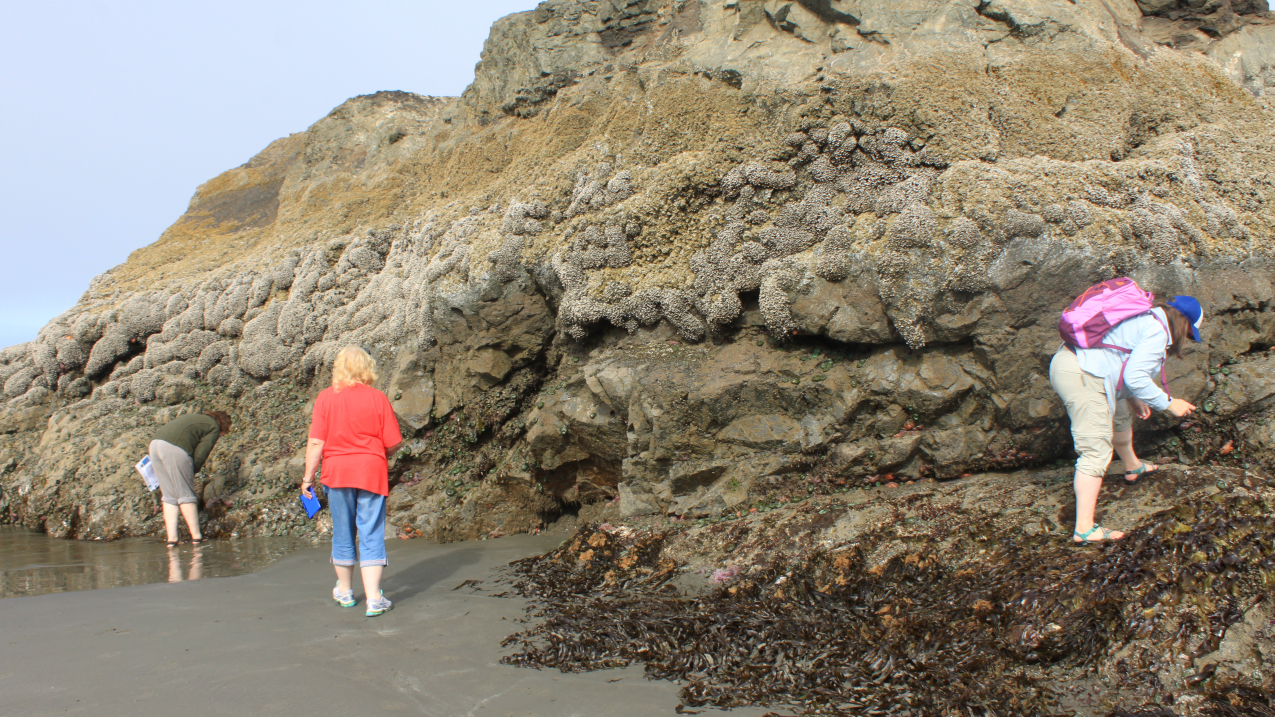Ocean acidification can be a daunting topic to cover in the classroom, but for Washington state’s coastal communities, the issue is often personal.

From July 24-26, 2017, Nicole Harris, Education Specialist for NOAA's Olympic Coast National Marine Sanctuary, held a teacher training workshop with the Pacific Education Institute on how to incorporate ocean acidification into their classrooms. The workshop included excursions to local tidepools at Ruby Beach, and here Nicole explores low tide with teachers, spotting species like sea cucumbers, sea stars, lichens, and hermit crabs. (Image credit: Maggie Allen/NOAA)
Ocean acidification can be a daunting topic to cover in the classroom, but for Washington state’s coastal communities, the issue is often personal. In 2005, billions of oysters died along the Northwest coast, and NOAA scientist Richard Feeley and other North American scientists have linked this and other shellfish die-offs deaths to falling ocean pH. According to Washington State’s Blue Ribbon Panel on Ocean Acidification, Washington’s ocean waters are specifically susceptible to ocean acidification because of coastal upwelling. This brings water that is low in pH and rich in carbon dioxide up from the deep ocean and onto the continental shelf. Ocean acidification, also exacerbated by nutrient runoff and local carbon emissions, threatens Washington’s marine environment, the state and local economies, and tribes.
Olympic Coast National Marine Sanctuary, which covers 3188 square miles of marine waters off Washington, is actively moving towards designation as an ocean acidification sentinel site. The designation will provide greater opportunities for interested citizens, graduate students, and researchers to study the shifting marine environment there. Olympic Coast National Marine Sanctuary Education Specialist Nicole Harris is also incorporating this pressing topic into many of the sanctuary’s education programs.
In collaboration with Pacific Education Institute offsite link, a Bay Watershed Education and Training (B-WET) grantee, Olympic Coast sanctuary hosted a three-day workshop, “Engineering Solutions for a Changing Environment,” at Olympic Coast Natural Resource Center in Forks, Washington from July 24-26. This workshop allowed local teachers of grades 4-6 to better understand ocean acidification and how to integrate it into their curricula.
Olympic Coast National Marine Sanctuary is an ideal outdoor classroom in which to investigate ocean health. Twelve teachers from the nearby small communities of Ocean Shores, Cosmopolis, Forks, Montesano, and Port Angeles visited tidepools to witness the diversity of life affected by the changing ocean conditions. They also discussed solutions with each other, learned about ocean acidification’s effects on the intertidal environment and local communities, and how to use Pacific Education Institute’s project-based learning model offsite link, which allows students to solve problems together in groups.
Most of the teachers plan to incorporate the workshop’s tools, resources, and new information into their classrooms. Reaching nearly 600 students each year, these teachers could have a huge impact on the communities of the Olympic Coast.
“I’m excited about using the project-based materials on implementing the effects of ocean acidification and how important it is to spread the word,” one teacher said.
Even though ocean acidification is an intimidating topic, many of the teachers walked away inspired from the workshop.
“Ocean Acidification seems to be larger than any one of us, but it isn’t,” one teacher commented, “There is something every one of us can do, today, to help reduce ocean acidification!”
During the three day professional development workshop, teachers developed potential solutions including a school garden, going on field trips to local beaches, having students brainstorm ways to save on energy costs, and creating incentives for students to use refillable water bottles. These solutions and more can help increase awareness and even help solve ocean acidification.
To learn more about ocean acidification, NOAA has many educational resources that describe the changing chemistry of the oceans and the potential impacts on marine ecosystems.



